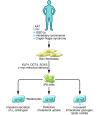From skin cells to hepatocytes: advances in application of iPS cell technology
- PMID: 20739747
- PMCID: PMC2929747
- DOI: 10.1172/JCI44422
From skin cells to hepatocytes: advances in application of iPS cell technology
Abstract
The discovery several years ago that fibroblasts and other somatic cells from mice and humans can be reprogrammed to become inducible pluripotent stem (iPS) cells has created enthusiasm for their potential applications in regenerative medicine and for modeling human diseases. Two independent studies in this issue of the JCI provide evidence that iPS cells represent a promising source of hepatocytes for a wide range of applications, including cell transplantation, drug toxicity testing, patient-specific disease modeling, and even ex vivo gene therapy. But how far have we come?
Figures


Comment on
-
Modeling inherited metabolic disorders of the liver using human induced pluripotent stem cells.J Clin Invest. 2010 Sep;120(9):3127-36. doi: 10.1172/JCI43122. Epub 2010 Aug 25. J Clin Invest. 2010. PMID: 20739751 Free PMC article.
-
Induced pluripotent stem cell-derived hepatocytes have the functional and proliferative capabilities needed for liver regeneration in mice.J Clin Invest. 2010 Sep;120(9):3120-6. doi: 10.1172/JCI43267. Epub 2010 Aug 25. J Clin Invest. 2010. PMID: 20739754 Free PMC article.
References
-
- Fisher RA, Strom SC. Human hepatocyte transplantation: worldwide results. Transplantation. 2006;82(4):441–449. - PubMed

